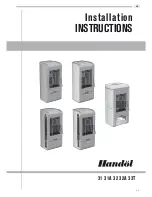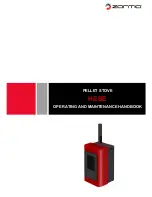
10.
10. Handling guide
Attention!
All national, regional, local laws, orders and regulations must be kept.
Therefore, depending on the location of installation, special operating condi-
tions and restrictions can be enforced regarding the period of use and fuels
used. It is important to consult a chimney sweep or other competent expert
before installing and using the appliance.
11.
Suitable fuels
Use the following fuels only:
- Dry wooden log (beech, oak,...)
- Wooden briquette
- Brown coal briquette
You can find the exact information on the technical data sheet and the type
board. You can only use these specific fuels. Usage of other fuels is not
allowed.
Depending on your choice of the fuels listed above, be sure that you use fuels
of good quality.
Wooden logs reach 15-20% humidity which is the most appropriate for heating
if they are stored outside for 1to 2 years (if they are covered and protected
from rain). Recently cut wood has a high moisture content and burns poorly
and causes soot. Apart from its very low heating value it is also a pollutant to
the environment. High condensation and tar can lead to blockage in the stove
and especially in the chimney. In all cases it causes deposit on the glass front
and emissions that need to be avoided.
Burning wood is recommended for operating the stove at its nominal capacity.
Watch the heating value of the fuel you use. You can get the exact data at a
fuel supplier. Load the fireplace with fuel according to heat demand. The heat-
ing value of 1 kg of dry wood is 4 - 4,5 kW/h. So you can place about 2,5 kg
of wood into a stove of 8 kW capacity every hour.
When burning wood, if you would like to reach a lower capacity, do not
restrain the fire. Put less wood in at one time instead.
Don't throw the fuel in the combustion chamber, because it can damage or
break the chamotte or vermiculite tiles. Be aware that the volume of some
types of wooden briquettes increases during burning. Choose the wooden bri-
quette that has the appropriate size to the measurements of the combustion
chamber and does not increase in size while burning.





































